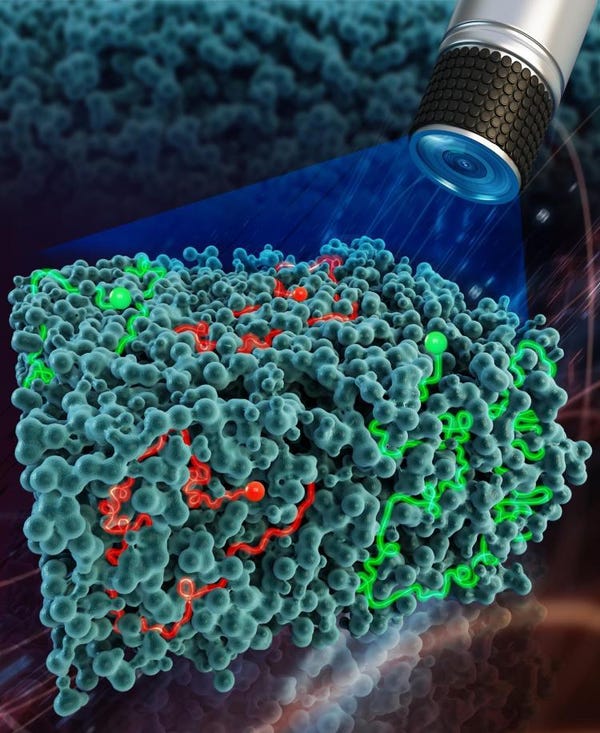Researchers have observed how self-propelled nanoparticles can move rapidly through and escape mazes that exist in porous materials.
July 13, 2021

Researchers may have found a nano-sized solution to everything from cleaning up the soil to improving water filtration to even delivering medications inside the human body.
A team from the University of Colorado Boulder has discovered that tiny, self-propelled particles called “nanoswimmers” can move very rapidly through and escape from material mazes, demonstrating the potential to quickly navigate porous materials.
Porous, sponge-like materials are widely used in numerous technologies because they can have an extraordinary amount of internal surface area; this makes them useful as catalysts for chemical reactions, filters to remove contaminants, and numerous other purposes, Daniel Schwartz, a professor of chemical and biological engineering at CU Boulder told Design News.
Similarly, complex interconnected porous spaces are important in geological environments such as soils and within biological tissues, he said. However, one challenge to these materials is that “motion through these porous void spaces is extremely inefficient since molecules and nanoparticles must essentially find their way the complex maze-like environments,” Schwartz told us.

Researchers long have believed that nanoswimmers might be able to navigate these mazes with ease; however, it’s been difficult to observe and model their movement in relevant environments, he said.
Until now, that is. Schwartz and his team have been able to observe nanoswimmers—in this case, Janus particles—by developing an imaging and modeling platform to do so. And what they discovered about their movement has broad ramifications, he said.
“Like the two-headed Roman god after which they are named, these particles have two distinct faces--one is inert and the other causes a chemical reaction to occur in the presence of a fuel (hydrogen peroxide in this case),�” Schwartz told us. “This chemical reaction drives the particle forward.”
Creating the Platform
Haichao Wu, a graduate student in chemical and biological engineering working with Schwartz, created the platform for observation of the nanoswimmers.
To do this, Wu used refractive index liquid—or liquid that affects how fast light travels through a material—in the porous medium. This rendered the maze essentially invisible while allowing the observation of 3D-article motion using a technique known as double-helix point spread function microscopy, researchers said.
In this way, Wu could track 3D trajectories of the particles and create visual representations of them—a major step forward for modeling such particles, researchers said. This modeling is key to the team’s ability to track and observe the movement of the Janus particles.
In their work, researchers made the self-propelled nanoswimmers try to move through a maze, made of a porous medium, and compared how efficiently and effectively they found escape routes compared to other passive nanoparticles called Brownian particles.
What they found is that the Janus particles were much more effective at escaping cavities within the maze—as much as 20 times faster than the Brownian particles. Their success came from how they moved strategically along the cavity walls searching for holes, which allowed them to find the exits very quickly. Their self-propulsion also appeared to give them a boost of energy needed to pass through the exit holes within the maze.
Material Composition
The Janus particles used in the research were comprised of polystyrene with one hemisphere coated in platinum, Schwartz told us. The platinum coating catalyzes the reaction that enables forward motion, he said.
“For the particle itself, polystyrene was a convenient choice, since the particle was easily made fluorescent, which enabled us to follow the particles using fluorescence microscopy,” Schwartz explained. “ However, in the long run, the particles can be made of many different materials, for example, silica will be another obvious choice.”
Another key aspect of the design of the Janus particles observed was their size, he said.
“In our experiments, we used particles that were 250 nm in diameter, which allowed them to move through very small openings,” Schwartz told Design News. “Interestingly, because of their very small size, these particles tend to tumble rapidly as they are propelled forward, which turned out to be an important feature.”
Researchers published a paper on their work in the journal Proceedings of the National Academy of Sciences.
Applications and Future Research
Potential applications for the work include “environmental remediation, in situ regeneration of industrial components (e.g. catalysts and filters), and possibly the delivery of therapeutics in vivo,” Schwartz told us.
“All of these applications require rapid and efficient motion within complex interconnected spaces that are usually poorly accessible,” he said.
Researchers plan to continue their work by developing and testing new types of nanoswimmers capable of using different fuels that potentially can be relevant for different technological applications.
“It’s also important to develop scalable ways to create the nanoswimmers themselves, which are currently made in small quantities,” Schwartz told us.
Researchers also aim to explore an understanding of the potential cooperativity between multiple nanoswimmers, or even between nanoswimmers and passive particles, “which could potentially lead to unexpected new phenomena,” he added.
Elizabeth Montalbano is a freelance writer who has written about technology and culture for more than 20 years. She has lived and worked as a professional journalist in Phoenix, San Francisco, and New York City. In her free time, she enjoys surfing, traveling, music, yoga, and cooking. She currently resides in a village on the southwest coast of Portugal.
About the Author(s)
You May Also Like



